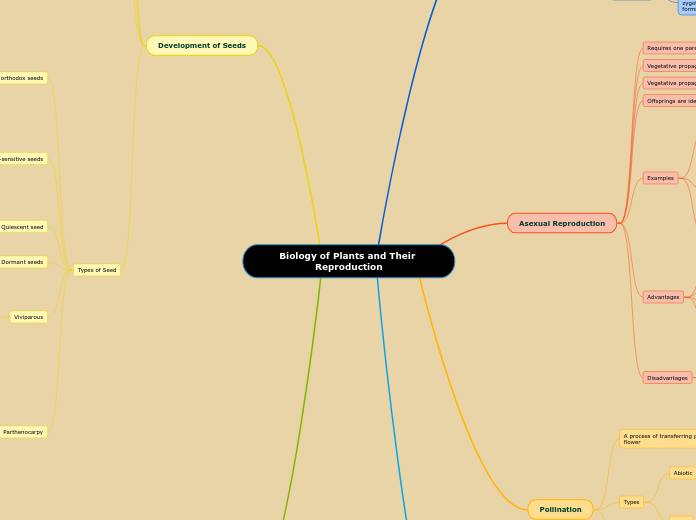Biology of Plants and Their Reproduction
Sexual Reproduction
Requires two parents
Female flowers – carpel
Male flowers – stamen
Fusion of gametes to produce new individuals - fertilization
Offspring produced are different from the parents – genetic variation
Gametophyte
Male gametes
Female gametes
Fertilization
known as double fertlization
This is due to the the sperm fuses with the egg cell forming a zygote (2n) and another sperm fuses with the polar nuclei forming triploid endoseprm (3n)
Asexual Reproduction
Requires one parent
Vegetative propagation
Vegetative propagation
Offsprings are identical to parents
Examples
Budding
T-budding
Patch budding
Grafting
Whip-and-Tongue Graft
Splice Graft
Cleft Graft
Wedge Graft
Stem cutting
Advantages
The offsprings are genetically identical and therefore advantageous traits can be preserved.
It is faster. Organisms multiply quickly
Many plants are able to tide over unfavorable conditions. This is because of the presence of organs of asexual reproduction like the tubers, corm, bulbs, etc
Vegetative propagation is especially beneficial to the agriculturists and horticulturists
They can raise crops like bananas, sugarcane, potato, etc that do not produce viable seeds
Disadvantages
gradually lose their vigor as there is no genetic variation. They are more prone to diseases that are specific to the species. This can result in the destruction of an entire crop
Since many plants are produced, it results in overcrowding and lack of nutrients
Pollination
A process of transferring pollen grain onto the stigma of a flower
Types
Abiotic
Wind
Water
Biotic
Insects
Birds
Mammals
Mechanism
Self-pollination
One flower pollinates the same flower on the same plant
Cross pollination
Transfering of pollen to another flower on different plant
Fruit formation
Some plants produce fruit containing seeds
Mature ovary
Tissue surrounding the embryo develops into fruit.
When the fruit is fully developed it drops off the plant, or is carried away by an animal
When fruit decomposes it releases the seed and germination can occur
Development of Seeds
A matured ovule containing an embryo which is usually the result of sexual fertilization
A protective outer covering
Storage tissue
An embryo
Seed Structure
Seed coat
Endosperm
Plumule
Radicle
Benefits
Spread progeny to colonize new environments
Major way plants reproduce in nature
Seedling = plant produced from seed
Stages of seed development
Stage I: Histodifferentiation
Embryo reaches the stage of developing cotyledons
Fresh and dry weight increases
Stage II: Cell Expansion
Rapid cell enlargement
Food reserves accumulate
Carbohydrates (starch)
Storage proteins
Lipids (oils/fats)
Different species accumulate reserves in different amounts
Stage III: Maturation Drying
Seeds are physiologically mature
Maximum dry weight is reached
High germination potential (viable and vigorous)
Rapid water loss
Vascular connection between “mother” plant and seed is severed
Seeds usually will not germinate when surrounded by fruit
Types of Seed
orthodox seeds
relatively small-seeded.
, these seeds can tolerate drying to as low as 5% moisture content under common conditions and low storage temperatures
Their life span is, in fact, prolonged with low seed moisture and temperature
recalcitrant or drying-sensitive seeds
are “readily killed by drying, most especially if their moisture content falls below the critical value ranging from 12-30%.
generally cannot withstand temperatures lower than 20 C, partly because of the high moisture content which renders the seed prone to chilling or freezing injury.
Some can maintain viability at slightly lower temperatures but vigor of the seedling may be affected
Quiescent seed
after maturation drying seeds fail to germinate since they are dry
after maturation drying seeds fail to germinate since they are dry
Dormant seeds
Fail to germinate even with favorable environmental conditions
Viviparous
seeds germinate prematurely on the plant (also called “precocious germination”)
Undesirable trait
Occurs on wheat and corn
Occurs on citrus and tomato
Due to a genetic mutation and environmental conditions
Reduced ABA production or insensitivity to ABA
Parthenocarpy
Fruit development without seed formation
Vegetative = fruit develops without pollination
desirable in greenhouse food crops such as
Cucumber
Tomato
Grapes
Can be artificially induced by spraying plants
Tomatoes respond to auxin
Grapes respond to GA
Types of fruit
Simple Fruits
Single ovary
Can be fleshy or dry
Cherry
Soy bean pod
Aggregate Fruits
Arise from a single flower with several carpels
Blackberry
Multiple Fruits
Arise from an inflorescence
Many flowers
As the walls of the many ovaries thicken,
they fuse and become one fruit
Pineapple
